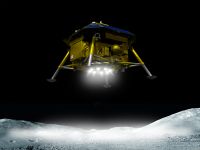SELENE-2
 | |
| Mission type | Orbiter lander rover |
|---|---|
| Operator | JAXA[1] |
| Spacecraft properties | |
| Launch mass | 5,000 kg[1] |
| Start of mission | |
| Launch date | Cancelled [2] |
| Rocket | H-IIA |
| Orbital parameters | |
| Reference system | Selenocentric |
SELENE-2 /ˈsɛlɪniː/, or the Selenological and Engineering Explorer 2, is a cancelled Japanese robotic mission to the Moon that would have included an orbiter, a lander and a rover.[3] It was intended as a successor to the 2007 SELENE (Kaguya) lunar orbiter.[4]
Overview[]
The lander would have targeted lava tubes and other permanently shadowed areas, which function as cold trap volatiles such as water. Water ice could be processed by future missions to produce spacecraft propellant (LOX/H2).[1]
- Orbiter
The orbiter would have a mass of 700 kg.[3]
- Lander
The lander would have a mass of 1,000 kg, and would be able to deliver up to 340 kg[1] of payload, including the rover. Its mission would last two weeks.[3]
- Rover
The rover would have a mass of 100 kg, and it would operate for two weeks.
Penetrators[]
One option JAXA was investigating in 2006, was to integrate a small data relay satellite and penetrators into the mission.[5]
References[]
- ^ a b c d Lunar Polar Exploration Mission. Tatsuaki Hashimoto, Takeshi Hoshino, Sachiko Wakabayashi, etal. Japan Aerospace Exploration Agency (JAXA). 6 January 2017.
- ^ Mission Concepts of Unprecedented Zipangu Underworld of the Moon Exploration (UZUME) Project. (PDF). Junichi HARUYAMA, Isao KAWANO, Takashi KUBOTA, etal. J-Stage. 3 July 2015. Accessed: 24 September 2018. Quote: "SELENE-2 was a mission with an intention to send a landing module to the Moon, and a lunar hole was a candidate for the landing site. However, the SELENE-2 mission was officially terminated in March 2015."
- ^ a b c Srinivas Laxman (2012-07-16). "Japan SELENE-2 Lunar Mission Planned For 2017". Asian Scientist. Retrieved 2012-08-07.
- ^ "Moon lander SELENE-2". JAXA Space Exploration Center. 24 December 2009. Archived from the original on 23 July 2010. Retrieved 2010-05-07.
- ^ Tatsuaki Hashimoto (May 2006). "Robotic Lunar Exploration Scenario" (.PDF). JAXA. Retrieved 2010-05-07. Cite journal requires
|journal=(help)
External links[]
- Manabu Kato, The Current Status of the Japanese Penetrator Mission Lunar-A, ISAS/JAXA, Information about the penetrator tests.
- Cancelled space probes
- Missions to the Moon
- Japanese Lunar Exploration Program
- Lunar rovers
- Robots of Japan
- Japanese space probes